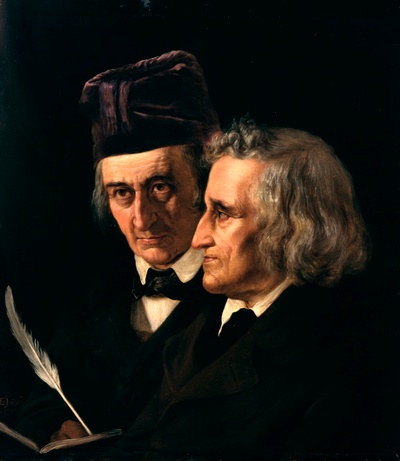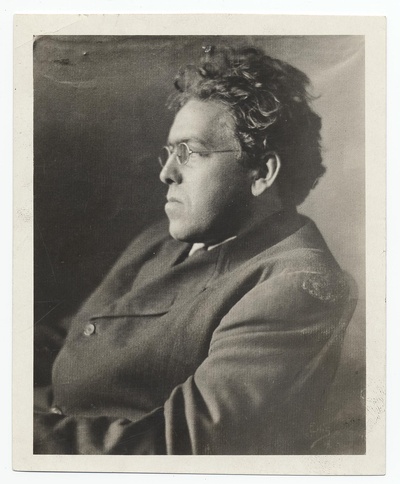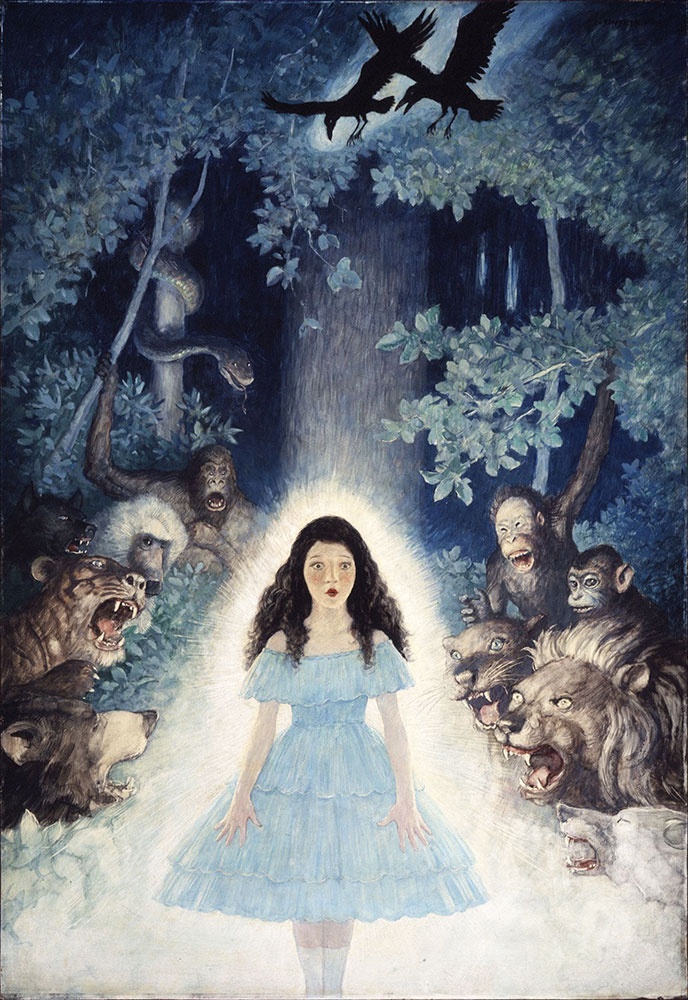The exhibition Into the Night features two paintings by N. C. Wyeth, The Admiral's Ghost and Snow-Drop. The first's title is somewhat explanatory (It's a ghost!), but the second is more confusing. Who or what is Snow-Drop? There's a good chance that you already know the answer — just under a different name.
Snow-Drop is the story of a young, fair princess and a jealous queen. Envious of the girl's beauty, the queen sends Snow-Drop out into the forest with a huntsman, instructing him to kill the girl and bring back her heart. The huntsman lets the girl go, and she wanders through the forest until she finds a cottage inhabited by seven little men...
Sound familiar? To most people living in the United States, that story would quickly be identified as "Snow White." Why does the Free Library's painting go under a different title? To answer that, we have to go back a few centuries and travel to Europe.
A Märchen
To properly discuss Snow-Drop or Snow White, we must discuss Jacob (1785–1863) and Wilhelm (1786–1859) Grimm, culture wars, and Napoleon.

Jacob (left) and Wilhelm (right) Grimm, as painted by Elisabeth Baumann (1855)
The Grimm brothers were the second and third of nine siblings, although their eldest brother Friedrich (1783–1784) died in infancy, making Jacob the oldest living child.1 As a result of this, Jacob was expected to provide for his family after his father died in 1796. While his grandfather and aunt provided financial assistance, both he and Wilhelm were sent to Kassel for their secondary school education and studied law at the University of Marburg. Jacob began in 1802, and Wilhelm joined him a year later. Both brothers excelled in their studies, and both studied medieval Germanic literature after being inspired by their law professor, Friedrich von Savigny.2 While at school, the brothers became passionate about the survival of their homeland's customs and culture.
Oftentimes, we refer to the Grimm brothers as "German," which is both true and misleading. They were born in what is now Germany, but at the time of their birth and young adult life, the area was the Holy Roman Empire. On August 6, 1806, Emperor Francis II abdicated, dissolving the empire and releasing all Imperial states, effectively rendering them independent countries. The reasons for his abdication were complex but can be roughly grouped into two categories: the overarching issue was that the Empire was over 1,000 years old, and there was a decline in its governing structure in the later years. The more contemporary problem — and one that was far more pressing — was the Napoleonic Wars (1803–1815). Fears of Napoleon and his army overtaking Europe were widespread, and Francis II's abdication blocked Napoleon from proclaiming himself Holy Roman Emperor.
People who lived in the Empire, like the Grimms, were terrified that their cultural heritage would be erased as Napoleon marched across Europe, destroying or disregarding histories and cultures that did not align with French ideals. The Grimm brothers' response was to transcribe as many Märchen — or folk tales — as possible in an attempt to prevent the tales from becoming lost.1 Their work resulted in the publication of Kinder- und Hausmärchen (Children's and Household Tales) in 1812.3 This first volume contained 86 tales, including "Sneewittchen (Schneewitßen)." Why the double title? The Grimms were fascinated with language, linguistics, and the various spellings, phases, and idioms used in different locations and wanted to capture both.
The initial response to Kinder- und Hausmärchen was unfavorable.5 The consensus among critics was that despite the name, the tales were not intended for children. And they weren't; Märchen are dark, and often contain themes of violence, assault, and abuse. Senior members of a family or a community would tell Märchen for the benefit of teenagers and young adults. The stories simplified the complex; they were used as tools to prepare the listeners for their transition into adult roles. In the first edition of Kinder- und Hausmärchen, the Queen was Sneewittchen's mother, not stepmother, and Sneewittchen enacted her revenge at her wedding. The Queen was invited and attended out of a morbid sense of curiosity, but when she arrived she discovered that "there were iron slippers made glowing in the fire, which [the Queen] had to put on and dance in, and her feet burned miserably, and she was not allowed to stop until she had danced herself to death."4
The Grimms heard the criticisms, and the 1819 edition changed the Queen from mother to stepmother. The burning shoes stayed, however. Everyone loves a good villain death scene.
A Mouse
Although initially criticized, Kinder- und Hausmärchen proved successful, and the stories were told to generations of children. They were also translated into a variety of languages, including English. The first is attributed to Edgar Taylor in 1823. In his translation, originally retitled German Popular Stories, Translated from the Kinder und Hausmärchen, Collected by M. M. Grimm, from Oral Tradition, Taylor calls the princess Snow-Drop, possibly due to the inspirations of her mother:7
It was the middle of winter, when the broad flakes of snow were falling around, that a certain queen sat working at a window, the frame of the window was made of fine black ebony; and as she was looking out upon the snow, she pricked her finger, and three drops of blood fell upon it. Then she gazed thoughtfully upon the red drops which sprinkled the white snow, and said, 'Would that my little daughter may be as white as that snow, as red as that blood, and as black as the ebony window-frame!' And so the little girl grew up; her skin was as white as snow, her cheeks were as rosy as the blood, and her hair as black as ebony; and she was called Snow-drop.
Taylor also changed the queen's death, absolving Snow-Drop of any maliciousness. In his translation, she attended her step-daughter's wedding feast but, "choked with passion, and fell ill and died."7 Perhaps everyone doesn't enjoy a good villain death scene after all.
Other translators, such as Lucy Crane, translated the title "Sneewittchen (Schneewitßen)" as "Snow-White."8 Both Snow-Drop and Snow-White were commonly used (with and without hyphens) for decades... until one of them was killed by a mouse.
Two years before that murder took place, in 1935, professor of English Edna Johnson and children's librarian Carrie E. Scott published a volume entitled The Anthology of Children's Literature.9 The book compiled samples of children's literature, including nursery rhymes, poetry, nonfiction, and more. It was a successful endeavor; so much so that the book was reissued in 1940 with artwork by the well-known illustrator N. C. Wyeth.10 Both editions included the story "Snow-Drop," as translated by Marian Edwards.

N. C. Wyeth, as photographed circa 1920.
However, in 1937, Snow-Drop was murdered.
A mouse, specifically Mickey (and his creator Walt Disney), obliterated Taylor's translation of Sneewittchen with the release of Snow White and the Seven Dwarves. It was the first fully animated movie created in America and became the highest-grossing film of the year.12 It remained the highest-grossing animated movie until being unseated by Aladdin in 1993, and if adjusting for inflation, would still top the chart.13
The erasure of "Snow-Drop" wasn't immediate, but it was thorough. Although the Wyeth edition of The Anthology of Children's Literature continued to use "Snow-Drop," the second edition (1948) subtitled the story as "Snow-White and the Seven Dwarfs." By the third edition in 1959, the subtitle became the title, and Edwards' translation was replaced by one from Wanda Gág.11
A Mystery
A frequently asked question at the Free Library is why we don't change the name of the picture in our Digital Collections. The answer is simple: that's not the name of the painting. Although the story changed, Wyeth's title of the piece, as seen on the recently digitized back of the board, did not. That's not the mystery alluded to in the title of this blog, though. The mystery is why Wyeth's Snow-Drop looks the way she does.
Glancing through the Anthology, you're able to see that Wyeth made stylistic choices to mirror the stories he was illustrating. In Arion and the Dolphin, Wyeth's depiction of the dolphins references classical Roman works, as the version of the myth in the Anthology places Arion's journey between Italy and Corinth. In Wyeth's Thumbelisa, the tiny girl's mother is depicted wearing a hovetcleet, a traditional structured veil worn in the Netherlands and France beginning in the 15th century. Wyeth was not afraid of historical references, but Snow-Drop is an anomaly. Her dress — with its ruffled layers, knee-length hemline, and knee-high socks — is contemporary. Her hair is unbound and long, reflecting the longer hairstyles that were becoming popular in the 1930s.
The animals surrounding Snow-Drop are also odd. The original translation refers to the creatures as "wild beasts," but Wyeth has gone a step further, adding a lion, a tiger, various primates, and a polar bear to the illustration. We do not have any documentation from Wyeth discussing his artistic choices. It's possible that he felt Snow-Drop's innocence could be reflected in a contemporary style, or he wanted young readers to identify with her. Perhaps his imagination dictated that the forest's inhabitants needed to be a diverse menagerie to heighten the fear of Snow-Drop's journey. They're all fine theories, but they're only conjectures. It's a mystery that continues, and one that I'm happy to reconsider every time Snow-Drop is on display.
Further Reading
1 Ashliman, D. L. "Chronology of Their Life." Grimm Brothers' Home Page. University of Pittsburgh, Updated: November 3, 2019, https://sites.pitt.edu/~dash/ashliman.html. Accessed: March 21, 2024.
2 Zipes, Jack. The Brothers Grimm: From Enchanted Forests to the Modern World. New York: Routledge,1988.
3 Grimm, Jacob and Wilhelm Grimm. Kinder- und Hausmärchen. Berlin: Realschulbuchh, 1812
4 Translation from Kinder- und Hausmärchen by Christopher Biss-Brown.
5 Tatar, Maria. The Hard Facts of the Grimms' Fairy Tales. Princeton: Princeton University Press, 1987
6 Ashliman, D. L. "Snow-White and other tales of Aarne-Thompson-Uther type 709" Grimm Brothers' Home Page. University of Pittsburgh, Revised: January 23, 2022, https://sites.pitt.edu/~dash/type0709.html. Accessed: March 21, 2024.
7 Grimm, Jacob and Wilhelm Grimm. German Popular Stories, Translated from the Kinder und Hausmärchen, Collected by M. M. Grimm, from Oral Tradition. Edgar Taylor, Translator. London: C. Baldwyn, 1823
8 Grimm, Jacob and Wilhelm Grimm. Household Stories from the Collection of the Bros. Grimm. Lucy Crane, Editor. London: MacMillan & Co., 1882
9 Johnson, Edna and Carrie E. Scott. Anthology of Children's Literature. Boston: Houghton Mifflin Company, 1935
10 Johnson, Edna and Carrie E. Scott. Anthology of Children's Literature. Boston: Houghton Mifflin Company, 1940
11 Johnson, Edna, Carrie E. Scott, and Evelyn R. Sickels. Anthology of Children's Literature. Boston: Houghton Mifflin Company, 1948
12 Jewell, Richard B. "RKO Film Grosses, 1929-1951: the C.J. Tevlin ledger". Historical Journal of Film, Radio and Television. 1994. Vol14, No. 1: Pg. 37-49.
13 Guinness World Records 2015. London: Guinness World Record Limited, 2014.
Many of the books discussed in this post are part of the Free Library of Philadelphia's Children's Literature Research Collection, one of the Special Collections housed at Parkway Central Library. To learn more about this collection, or to book an appointment, visit freelibrary.org/clrc.
Have a question for Free Library staff? Please submit it to our Ask a Librarian page and receive a response within two business days.

